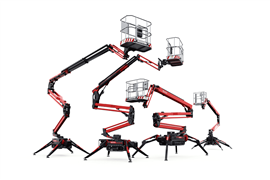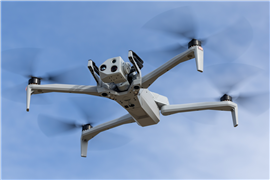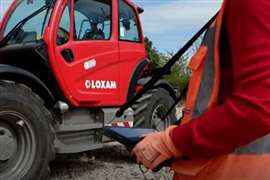Read this article in French German Italian Portuguese Spanish
Clean revolution: Alternative power takes rental equipment by storm
24 April 2024
While diesel-powered equipment might remain dominant on sites around the world, goals to reduce emissions mean OEMs are innovating with solar, electric and hydrogen-powered machines.
From electric excavators to solar-powered generators, recent developments have marked a significant stride toward a greener and more efficient future in construction and rental industries.
Electric alternatives
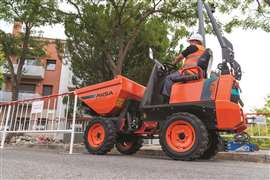 Spain-based Ausa says it is meeting rental demands for compact units for use in emission-free zones with its D101AEA electric dumper.
Spain-based Ausa says it is meeting rental demands for compact units for use in emission-free zones with its D101AEA electric dumper.
In the electric range, run-time anxiety and performance are often barriers for the end user. To this point, Junior van Remortele, director, big truck sales EMEA, Hyster Europe, says lithium-ion batteries ensure the machine offers the same performance of a diesel-powered unit.
He says, “Lithium-ion batteries can provide an electric option capable of delivering the diesel-like performance tough operations require. This capability is possible because lithium-ion batteries can tolerate a high energy draw without overheating or dropping in efficiency.
“Lithium-ion technology also provides far greater energy density, power transfer, and service life than lead-acid batteries.”
Meanwhile, Spain-based Ausa says it is meeting rental demands for compact units for use in emission-free zones with its D101AEA electric dumper.
Launched in November 2023, the machine has a battery pack with a maximum power of 17.3kW and a torque of 130Nm, allowing it to tackle any terrain and match the performance of a diesel dumper. Other features include a one tonne payload and hi-tip skip with a lifting and tipping height of up to 1.6m.
The lithium-ion batteries have a capacity of 9.3kWh and can be charged from 20% to 80% in two hours by plugging them directly into a 230V mains socket, or in one hour with an external fast charger.
Elsewhere, JCB unveiled its A45E electric articulated boom access platform at the Executive Hire Show in February.
Powered by eight 6V batteries, creating a 48V, 400AH operating system, the machine offers a maximum platform height of 13.84m, 7.47m forward reach and 300kg lift capacity.
JCB says the battery packs are located on either side of the lower chassis, enabling it to maintain a low centre of gravity for added stability and improved traction.
The A45E has a four-wheel drive and two-wheel steering as standard and is capable of climbing up to 40% gradients, while the platform itself measures 0.84m by 1.84m.
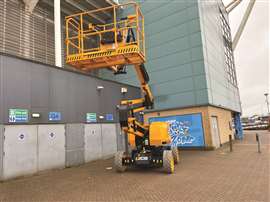 JCB unveiled its A45E electric articulated boom access platform at the Executive Hire Show in February.
JCB unveiled its A45E electric articulated boom access platform at the Executive Hire Show in February.
In addition to four harness clipping positions, a secondary guarding system is provided, automatically halting boom functions when triggered, to protect the operator and prevent crushing.
Other featured include JCB’s LiveLink telematics monitoring system for real-time operating data, puncture-proof tires, slew lock and emergency override.
In the heavier range of equipment, Liugong launched a 21-tonne electric wheeled loader into the European market in September 2023.
The 856HE is powered by a 423kWh large-capacity lithium-ion phosphate battery from CATL and is said to be the first fully electric wheeled loader available in Europe.
It has a duty cycle of up to 11 hours, depending on the type of work, and can be charged via a standard charge over 10 hours or a fast charge which takes the machine from 25% to 90% in 45 minutes.
The standard bucket measures in at 3.5m³, while its payload of 6.5 tonnes means it delivers on performance as well as sustainability, the company told IRN at its unveiling in London.
Oliver Keates, wheel loader product manager at LiuGong says, “With the Scandinavian machines, green and carbon neutrality is one big benefit, as well as the working time of the machine and the cost benefits when compared with a standard diesel machine.
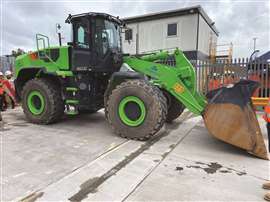 Liugong launched a 21-tonne electric wheeled loader into the European market in September 2023.
Liugong launched a 21-tonne electric wheeled loader into the European market in September 2023.
“The charging capacity on the machines generally will increase, and the availability of those chargers will become more frequent. The machine also delivers very small noise pollution, but you still have the productivity, efficiencies and the ability to have the machine work at full capacity when it needs to.”
Back in the smaller range, Ammann launched a 1.5t electric mini excavator last year. Powered by a 21.5kW lithium-ion battery that enables the machine to operate for up to eight hours, the eAMX 15 is designed for inner city sites and for indoor demolition work.
Charging takes 10 hours, although a fast charger can get up to 80% in one hour, the company says. The chassis and blade are 1050mm wide, but can be retracted to a width of 790 mm, and total height is 2300 mm.
Ammann says it is also working on a 2.5 tonne machine, which is set for launch this year.
Hydrogen development
According to Doosan Bobcat, it has taken “a first step towards pioneering the commercialization of hydrogen fuel cell forklifts in Korea” with its inaugural hydrogen forklift.
The hydrogen-powered B35X-7P is a 3-tonne model equipped with a 20kW fuel cell, while 2- and 5-tonne models are also in the works, with plans also announced to further expand the use of
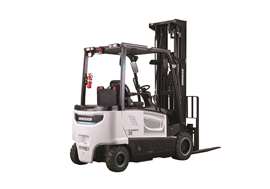 Doosan Bobcat has taken “a first step towards pioneering the commercialization of hydrogen fuel cell forklifts in Korea” with its inaugural hydrogen forklift.
Doosan Bobcat has taken “a first step towards pioneering the commercialization of hydrogen fuel cell forklifts in Korea” with its inaugural hydrogen forklift.
hydrogen to other product lines. These include hydrogen skid-steer loaders, which are currently under development with Doosan Corporation.
Doosan says it has set a target to supply 30 hydrogen forklifts in 2024.
Hyungwon Park, president of Doosan Bobcat Korea, comments, “As Korea’s first manufacturer to produce forklifts in 1968, Doosan Bobcat is proud to continue paving the way for the country by commercializing hydrogen fuel cell forklifts.
“We are committed to actively participating in the expansion of hydrogen mobility, as it’s a pivotal future energy source in the low-carbon era.”
Meanwhile, hydrogen-fueled industrial generators from Belgian manufacturer e-power are now available in the UK and Ireland, thanks to a distribution agreement with Commercial Fuel Solutions.
One such unit, the 45kVA Hydrogen Combustion Engine (H2ICE) Electrical Power Generator, is powered by a 3.7l Ford V6 Hydrogen Combustion Engine that delivers prime energy power of 40KVA.
Commercial Fuel Solutions says, “The 45 kVA H2ICE Generator harnesses the power of hydrogen through the combustion process, delivering reliable electrical power without the emissions
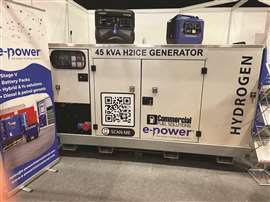 Hydrogen-fueled industrial generators from Belgian manufacturer e-power are now available in the UK and Ireland, thanks to a distribution agreement with Commercial Fuel Solutions.
Hydrogen-fueled industrial generators from Belgian manufacturer e-power are now available in the UK and Ireland, thanks to a distribution agreement with Commercial Fuel Solutions.
associated with traditional fossil fuel-based generators. This approach not only ensures near zero emissions but also capitalizes on the cost advantages when using hydrogen as a fuel source.”
In the access world, 2023 saw Speedy Hire and Niftylift collaborate to manufacture the world’s first hydrogen-electric powered access platform in a three-year partnership worth £9 million.
According to the companies, the hydrogen fuel cell technology was developed to provide a commercially sustainable product and to meet net zero targets in the UK construction sector and is the “first viable alternative to diesel-powered equipment available on the market.”
“The hydrogen-electric platform can typically be operated for up to five days on a single electric charge, with additional range available from the hydrogen fuel cell, emitting zero carbon into the atmosphere without compromising on reliability,” Speedy says.
Solar and hybrid solutions
Meanwhile, UK-based renewable lighting and power specialist Prolectric launched a solar hybrid lighting tower earlier this year.
The ProRXM Hybrid is described as a “solar first solution” that offers a backup option via traditional diesel power.
The unit is fully powered by three 270W solar panels with 8kWh of usable battery bank storage, while a DC 2.8kW generator utilizes 0.5 litres per hour.
The generator starts up automatically when power demands exceed the battery charge.
Four multi-directional 180W LED lights on a 360° pan motor rotatable hydraulic mast can be dimmed, monitored, and scheduled remotely thanks to the company’s remote monitoring and reporting software.
Prolectric says the unit is designed to meet market demand for a hybrid products, and represents its first move into the hybrid space having previously launched three solar-only units.
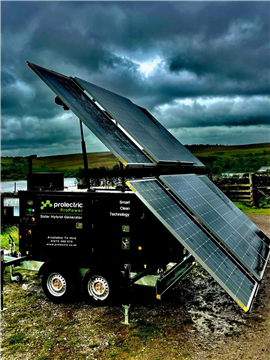 UK-based renewable lighting and power specialist Prolectric launched a solar hybrid lighting tower earlier this year.
UK-based renewable lighting and power specialist Prolectric launched a solar hybrid lighting tower earlier this year.
The company told IRN that it is working on a five-panel model, with early indicators suggesting a launch at some point this year.
Elsewhere, Atlas Copco launched its first light tower in the hybrid range in December. The HiLight BI+ 4 integrates lithium-ion batteries with a low-consumption Stage V diesel engine and can draw power from mains electricity, lithium-ion batteries, the diesel engine or a hybrid setting.
Operating at full capacity, the towers offer a seven-hour battery autonomy, extending to over 20 hours when using the dimming function, delivering silent and emission-free operation with a single charge.
Additionally, the 5kW battery can last approximately 36,500 hours, compared to 1,500 hours for absorbent glass mat (AGM) lead acid batteries, while Atlas Copco says recharging takes four hours, with an external power plug available as an additional feature.
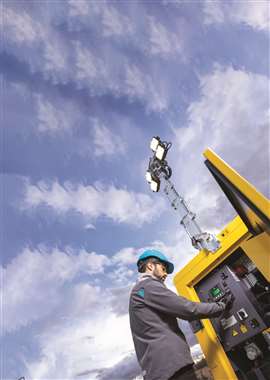 Atlas Copco’s HiLight BI+ 4 integrates lithium-ion batteries with a low-consumption Stage V diesel engine and can draw power from mains electricity, lithium-ion batteries, the diesel engine or a hybrid setting.
Atlas Copco’s HiLight BI+ 4 integrates lithium-ion batteries with a low-consumption Stage V diesel engine and can draw power from mains electricity, lithium-ion batteries, the diesel engine or a hybrid setting.
In hybrid mode, the tower has an average fuel consumption of 0.29 liters per hour, while the use of a battery system means operators can reduce up to seven tonnes of CO2 per unit, per year, compared to traditional diesel-powered light towers.
Atlas Copco says the inclusion of a surface mount device (SMD) LED lighting technology and lithium-ion batteries provides “excellent performance and efficiency” while offering users a unit that reduces their carbon footprint and operating costs while improving sustainability levels.
The SMD LED lights are said to be 20% more efficient than alternative Chip-on-Board (COB) LED lights, with each light tower coming with four floodlights that provide 150W power to cover 4,000m2.
STAY CONNECTED



Receive the information you need when you need it through our world-leading magazines, newsletters and daily briefings.
CONNECT WITH THE TEAM










